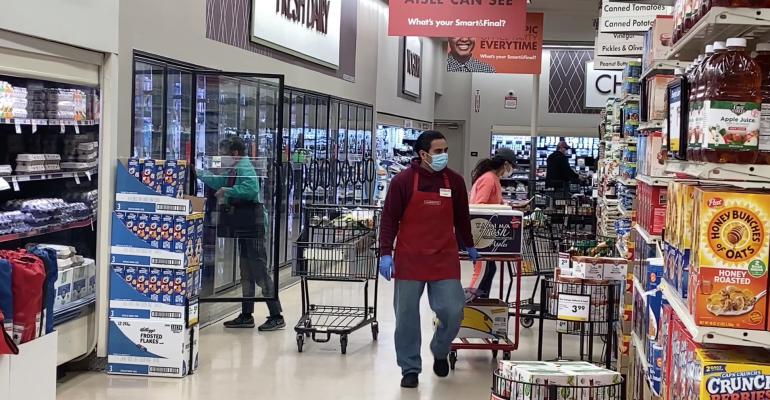Two years into the pandemic, many consumer packaged goods (CPG) categories seeing an initial growth surge remain higher than pre-COVID sales levels, with some generating further gains, according to digital marketing and media firm Catalina.
St. Petersburg, Fla.-based Catalina said its Buyer Intelligence Platform shows four of the top 10 categories with the largest sales growth in 2020 tallied strong year-over-year increases in 2021, while six posted declines. However, nine of the 10 show elevated sales on a two-year stack. The World Health Organization declared COVID-19 a global epidemic on March 11, 2020, and the United States designated the virus as a national emergency two days later.
Unsurprisingly, home health testing (including face masks, COVID-19 home test kits, etc.) turned in the largest dollar sales/store growth, up 251% for the 52 weeks ended March 13, 2021, and up 100% for the 52 weeks ended March 12, 2022.
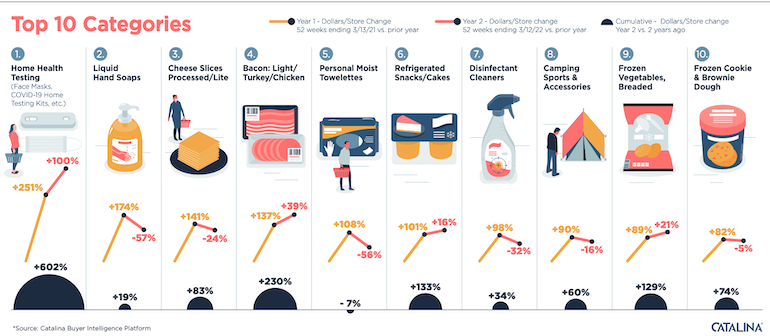
“A year ago, face masks accounted for 80% of the home health testing category. Their strong sales performance has continued, even as masking guidelines established by the CDC have evolved and COVID-19 home testing kits were launched in April 2021,” Catalina stated. “The data also reveals that people by and large are still conscious about fighting germs, just not as much, with sales for liquid hand soaps, personal moist towelettes and household disinfectants all dropping in 2021 but currently still reflecting higher sales than pre-pandemic levels.”
Among the top 10, also realizing robust growth during the 2021 period were bacon at +39% (+137% in 2020), refrigerated snacks/cakes at +16% (+101% in 2020) and breaded frozen vegetables at +21% (+89% in 2020).
“Three of the top 10 categories are foods that continue to show an increased appetite for convenience and/or comfort, including processed cheese slices, bacon, refrigerated cookie and brownie dough and snacks/cakes, and frozen breaded vegetables,” Catalina observed. “An outlier includes the camping/sports accessories category, which continues to reflect consumers wanting to spend more time outdoors.”
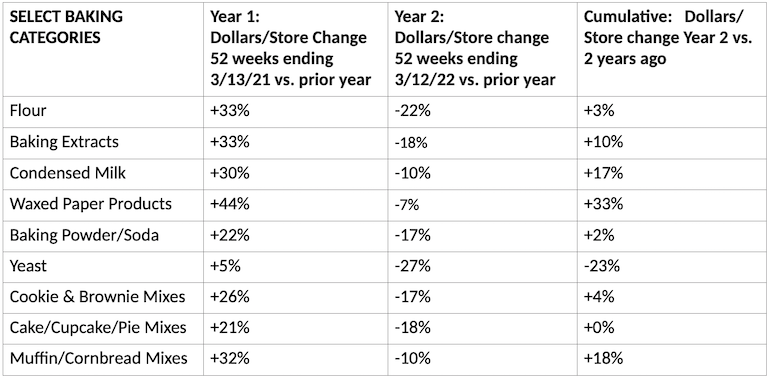
The baking needs category received a huge sales lift in the pandemic’s first year as more Americans stayed home. While that product area has since seen sales recede, key segments have upheld increases versus the pre-pandemic period. They include two-year gains of 10% baking extracts (+33% in 2020), 17% for condensed milk (+30% in 2020), 33% for waxed paper products (+44% in 2020), 18% for muffin/cornbread mix (+32% in 2020), 4% for cookie and brownie mix (+26% in 2020), 3% for flour (+33% in 2020) and 2% for baking powder/soda (+22% in 2020).
“The rise of home baking as a hobby has stuck, though not at the same level as year one [of COVID], as categories like flour, condensed milk, baking extracts and waxed paper products have fallen but are still higher than pre-pandemic levels,” according to Catalina. “Scratch baking may not be quite as popular, with yeast sales continuing to decline over the past year, but brownie, cookie and cornbread mixes continue to sell well.”
Adult/alcoholic beverage experienced a similar trend. Pre-mixed cocktail and cooler sales climbed 41% in the 2021 period for two-year growth of 130%. Two-year sales also remain elevated for domestic beer/ale at +10% (+17% in 2020), imported beer/ale at +5% (+11% in 2020), imported wine at +3% (+16% in 2020), domestic wine at +3% (+13% in 2020) and spirits at +6% (+18% in 2020).
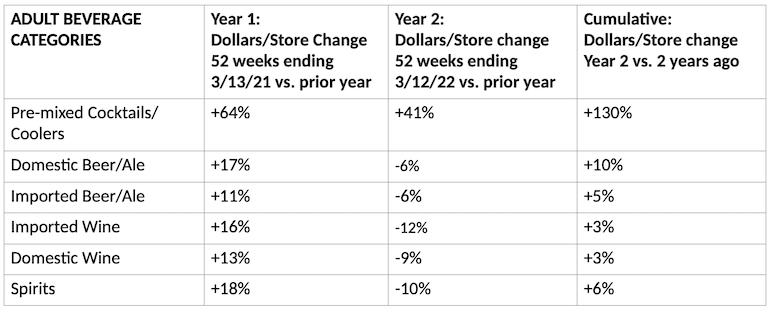
“With most bars and restaurants either closed, open only for takeout and/or offering limited seating, adult beverages experienced strong sales upticks the first year of the pandemic,” Catalina said. “There was a pullback as more people started socializing and dining out again in 2021-22, though sales of alcoholic beverages are still above pre-pandemic levels.”
Beauty and personal care sales rebounded in 2021 but remain down on a two-year basis after dropping amid shutdowns and public restrictions in year one of the pandemic. For example, wrinkle reducers (+19%), breath fresheners (+23%), facial cosmetics (+21%), cosmetic remover (+16%), eye makeup (+21%) and hair care/styling (+17%) all saw double-digit increases in the 2021 period after plunging in 2020 yet remained down by double digits — except for eye cosmetics (-4%) and hair care (-6%) — over two years.
“With so many Americans working or studying from home during year one of the pandemic, sales of personal care products initially dropped but then started to recover as COVID transmission and hospitalization rates began to fall early in year two,” Catalina explained. “They then started to decline again when the Omicron variant began to spread later in the year.”
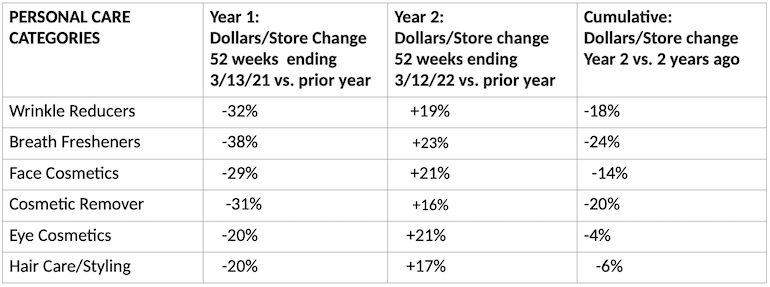
Looking at shopping trends, Catalina said the past two years of data starting from the week ended Feb. 15, 2020 — when coronavirus concerns gained traction in the United States — customers made more trips than average in March 2020 when the pandemic set in but slashed the number of trips that April as they began sheltering at home.
“The subsequent impact of lockdowns, masking and social distancing paved the way for a lasting decline in weekly, in-person shopping trips starting in May 2020, compared to the prior year. That trend continues as guidelines from the Centers for Disease Control (CDC) continue to shift,” Catalina commented.
Although U.S. consumers generally have been shopping less, they continue to purchase more in-store. Spending per trip has risen 22% on average versus pre-pandemic levels, Catalina reported. Overall, average weekly spending on groceries has grown 16%.

